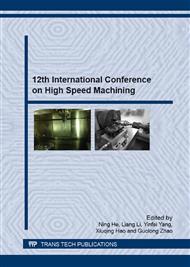[1]
Bozga Marius Bogdan, Popa Marcel Sabin, UNCONVENTIONAL TECHNOLOGIES IN PREPARATION OF MICROGEOMETRY EDGES ON CUTTING TOOLS[J], Romanian Association of Nonconventional Technologies, 12 (2013) 10-16.
Google Scholar
[2]
Tugrul Özel, Computational modelling of 3D turning: Influence of edge micro-geometryon forces, stresses, friction and tool wear in PcBN tooling, Journal of Materials Processing Technology. 209 (2009) 5167-5177.
DOI: 10.1016/j.jmatprotec.2009.03.002
Google Scholar
[3]
P. I. Varela, C. S. Rakurty, A. K. Balaji, Surface Integrity in Hard Machining of 300M Steel: Effect of Cutting-Edge Geometry on Machining Induced Residual Stresses, Procedia CIRP. 13 ( 2014 ) 288-293.
DOI: 10.1016/j.procir.2014.04.049
Google Scholar
[4]
Paolo Claudio Priarone, Stefania Rizzuti, Effects of cutting angle, edge preparation, and nano-structured coating on milling performance of a gamma titanium aluminide, Journal of Materials Processing Technology. 212 (2012) 2619-2628.
DOI: 10.1016/j.jmatprotec.2012.07.021
Google Scholar
[5]
C. F. Wyen,K. Wegener, Influence of cutting edge radius on cutting forces in machining titanium, CIRP Annals - Manufacturing Technology. 59 (2010) 93-96.
DOI: 10.1016/j.cirp.2010.03.056
Google Scholar
[6]
Bernhard Karpuschewski, Konrad Schmidt, Julia Prilukova, Influence of tool edge preparation on performance of ceramic tool inserts when hard turning, Journal of Materials Processing Technology. 213 (2013) 1978-(1988).
DOI: 10.1016/j.jmatprotec.2013.05.016
Google Scholar
[7]
Jia Xiujie, Li Jianfeng, Sun Jie, Influence of cutting tool blade passivation on cutting force and surface roughness, Computer Integrated Manufacturing Systems. 17 (2011) 1430-1434.
Google Scholar
[8]
Yan Xianguo, Pang Siqin, Li Yongtang, Electrolyic Strengthening Technology of Cutting Edge of High-speed Steel Taps, JOURNAL OF MECHANICAL ENGINEERING. 45 (2009) 203-207.
DOI: 10.3901/jme.2009.04.203
Google Scholar
[9]
Hu Jianglin, Xue Qian, He Fengbao, Zhang Wei, Expreimental Research on Electrochemical-machining Edge Honing Process of Cemented Carbide Gun Drill, CEMENTED CARBIDE. 29 (2012) 33-37.
Google Scholar
[10]
Mamilla Ravi Sankar, V.K. Jain, J. Ramkumar, Experimental investigations into rotating workpiece abrasive flow finishing, Wear. 267 (2009) 43-51.
DOI: 10.1016/j.wear.2008.11.007
Google Scholar


